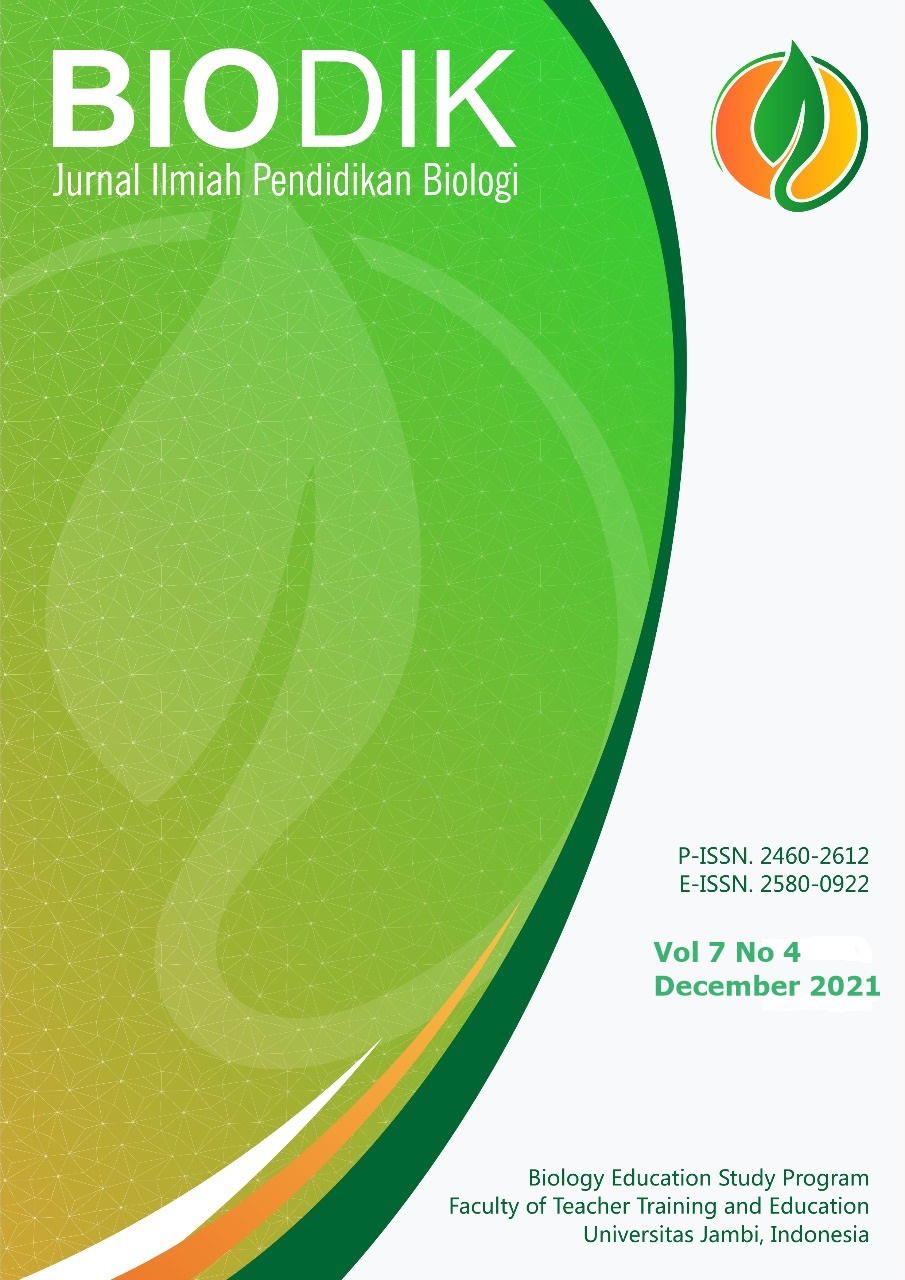Pengembangan Media Pembelajaran Protista Dan Fungi Melalui Bot Aplikasi Telegram
(Development of Learning Media for Protists and Fungi through Telegram Application Bot)
DOI:
https://doi.org/10.22437/bio.v7i4.11403Abstract
This study aims to develop virtual learning media using the telagram bot application in learning biology of the functional protist material and the feasibility of virtual learning media using the telegram bot application in learning. Students have a high level of difficulty in understanding and describing the life cycle of fungi. Based on this, a solution is needed that can help students and lecturers to overcome the limitations of the object to be observed by presenting the media in learning. Multimedia will stimulate some students 'sensory organs, so that students' understanding of biology becomes more perfect. Compared to conventional learning, m-learning allows more opportunities for ad hoc collaboration and informal interaction among learners. This study uses a Research and Development type of research (research and development) by developing the DDD-E model, namely decide, design, develop and evaluate. The research results obtained that, the assessment of the material results from all aspects of the assessment for the validation of the telegram bot as a learning medium is the result of the validation of the interactive multimedia learning telegram bot, the biology of the protist function, in the presentation aspect, it is obtained 85% with a very valid category.The overall media feasibility aspect has a percentage of 87 , 6%. Thus the learning bot produced in this study can be used as a reference in multimedia learning courses.
Abstrak.
Penelitian ini bertujuan untuk mengembangkan media pembelajaran virtual dengan menggunakan aplikasi bot telagram dalam pembelajaran biologi materi protista fungi dan kelayakan media pembelajaran virtual meggunakan aplikasi bot telegram dalam pembelajaran. Siswa memiliki tingkat kesulitan yang tinggi dalam memahami dan mendeskripsikan siklus hidup jamur. Berdasarkan hal tersebut maka diperlukan suatu solusi yang dapat membantu mahasiswa dan dosen dalam mengatasi keterbatasan objek yang akan diamati dengan penyajian media dalam pembelajaran. Multimedia akan merangsang beberapa
organ sensorik siswa, sehingga pemahaman siswa terhadap biologi menjadi lebih sempurna. Dibandingkan pembelajaran konvensional, m-learning memungkinkan adanya lebih banyak kesempatan untuk kolaborasi secara ad hoc dan berinteraksi secara Informal di antara pembelajar. Penelitian ini menggunakan jenis penelitian Research and Development (penelitian dan pengembangan) dengan pengembangan model DDD-E yaitu decide, design, develop dan evaluate. Hasil penelitian yang diperoleh bahwa, penilaian hasil materi dari keseluruhan aspek penilaian untuk validasi bot telegram sebagai media pembelajaran  adalah Hasil validasi multimedia pembelajaran interaktif bot telegram materi biologi protist fungi pada aspek penyajian diperoleh 85% dengan kategori sangat valid Aspek kelayakan media secara keseluruhan meiliki presentase 87,6%. Dengan demikian bot pembelajaran yang dihasilkan dalam penelitian ini dapat dimanfaatkan sebagai salah satu referensi dalam mata kuliah multimedia pembelajaran.Â
Downloads
References
Arsyad Azhar. 2013. Media Pembelajaran. Jakarta : Pt Raja Grafindo Persada
Arsyad, Azhar. 2015. Media Pembelajaran. Jakarta: PT RajaGrafindo Persada
Asyhar, Rayandra. 2012. Kreatif Mengembangkan Media Pembelajaran. Jakarta: Referensi Jakarta.
Rusman, dkk (2011) Pembelajaran Berbasis Teknologi Informasi dan Komunikasi : Mengembangkan Profesionalisme Guru. Jakarta:Rajawali Pers. PT. Raja Grafindo Persada
Saribekyan, Hayk dan Margvelashvili, Akaki. 2017. Security Analysis of Telegram,
Satyaprakasha. 2014. “Research Studies of Effect of Cooperative Learning on Children’s Learning Preferenceâ€. International Journal of Informative and Futuristic Reseacrh. Vol. 2. Issue. 4. Hal. 1100-1106.
Sugiyono. 2010. Metode Penelitian Kualitatif, Kuantitatif, dan R&D. Bandung: Alfabeta.
Tamimuddin, Muhammad. 2007. Mengenal Mobile Learning. LIMAS edisi 18.
Wibawa, Setya Chendra; Harimurti, Rina; Anistyasari, Yeni dan Sumbawati, Meini Sondang. 2017. The Design And Implementation Of An Educational Multimedia Interactive Operation System Using Lectora Inspire.
Widoyoko, Eko Putro. 2011. Teknik Penyusunan Instrumen Penelitian. Yogyakarta: Pustaka Pelajar.
Downloads
Published
How to Cite
Issue
Section
License
Copyright (c) 2021 Nur Chusnul Chotimah Ratna Sari, Evi Roviati

This work is licensed under a Creative Commons Attribution-NonCommercial-ShareAlike 4.0 International License.
Copyright Notice
Authors who publish with Biodik : Jurnal Ilmiah Pendidikan Biologi agree to the following terms:
- For all articles published in Biodik : Jurnal Ilmiah Pendidikan Biologi, copyright is retained by the authors and grant the journal right of first publication with the work simultaneously licensed under a Creative Commons Attribution-ShareAlike 4.0 International Licensethat allows others to share the work with an acknowledgment of the work's authorship and initial publication in this journal.
- Authors are able to enter into separate, additional contractual arrangements for the non-exclusive distribution of the journal's published version of the work (e.g., post it to an institutional repository or publish it in a book), with an acknowledgment of its initial publication in this journal.
- Authors are permitted and encouraged to post their work online (e.g., in institutional repositories or on their website) prior to and during the submission process, as it can lead to productive exchanges, as well as earlier and greater citation of published work (See The Effect of Open Access).
















